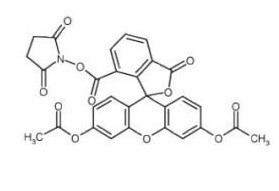
| 规格 | 价格 | 库存 | 数量 |
|---|---|---|---|
| 1mg |
|
||
| 5mg |
|
||
| 10mg |
|
||
| 25mg |
|
||
| 50mg |
|
||
| 100mg |
|
||
| 250mg |
|
||
| Other Sizes |
|
| 靶点 |
Fluorescent dye
|
|---|---|
| 体外研究 (In Vitro) |
CFDA-SE工作液的制备
1.1 制备储备液:将1毫克CFDA-SE溶解在0.1794毫升DMSO中,得到10毫摩尔的CFDA-SE储备液。 注意:储备液应在-20℃或-80℃下避光储存,避免反复冻融。 1.2 CFDA-SE工作溶液的制备 在无血清细胞培养中稀释储备溶液。 注意:请根据您的具体实验需求调整CFDA-SE工作液的浓度。 细胞染色 2.1 悬浮细胞:在4°C下以1000 g离心3-5分钟,丢弃上清液。用PBS洗两次,每次五分钟。 粘附细胞:丢弃细胞培养基,用胰蛋白酶分离细胞,产生单细胞悬浮液。在4°C下以1000 g离心3-5分钟,丢弃上清液。用PBS洗两次,每次五分钟。 2.2 加入1 mL CFDA-SE工作溶液并混合30分钟。 2.3 在4°C下以400 g离心3-4分钟。 2.4 用PBS洗涤细胞两次,每次5分钟。 2.5 将细胞重新悬浮在无血清培养基或PBS中,并使用荧光显微镜或流式细胞仪进行检测。 |
| 体内研究 (In Vivo) |
CFDA-SE是一种细胞内绿色荧光染料,可用于检测体内菌株定殖。
方法:用于测定肠道中的菌株定植。 1.将菌株重新悬浮在PBS中,以获得108 CFU/mL的细胞密度。 2.将CFDA-SE(1 mM;10μL;20分钟;37°C;黑暗/避光)加入1 mL细菌悬浮液中。 3.离心(13000 g,10分钟,4°C),用无菌PBS洗涤混合物3次,以去除多余的CFDA-SE。 4.将菌株重新悬浮在无菌PBS(108 CFU/mL)中,并向SD大鼠施用1 mL细菌悬浮液。灌胃后第1天和第3天,对麻醉的大鼠进行荧光成像,然后处死大鼠,取不同的肠道切片进行成像。 5.使用IVIS Lumina III智能成像系统进行荧光成像。 |
| 细胞实验 |
本单元中描述的技术使用细胞内荧光标记羧基荧光素二乙酸酯琥珀酰亚胺酯(CFSE)来追踪增殖细胞。共价结合的CFSE在子细胞之间平均分配,从而可以区分连续几轮的细胞分裂。该技术适用于体外细胞分裂,也适用于过继转移细胞的体内分裂,可以分辨连续八代或更多代。CFSE寿命长,可以在细胞转移后几个月内进行分析,并且具有与荧光素相同的光谱特征,因此与藻红蛋白或其他相容的荧光染料结合的单克隆抗体可用于对分裂细胞进行免疫表型。此外,还提供了关于第二代染料Cell Trace Violet(CTV)的信息,该染料由405nm蓝色激光激发。CTV在化学上与CFSE有关,但允许氩激光的488nm线用于其他探针[2]。
|
| 参考文献 | |
| 其他信息 |
We developed a series of models for the label decay in cell proliferation assays when the intracellular dye carboxyfluorescein succinimidyl ester (CFSE) is used as a staining agent. Data collected from two healthy patients were used to validate the models and to compare the models with the Akiake Information Criteria. The distinguishing features of multiple decay rates in the data are readily characterized and explained via time dependent decay models such as the logistic and Gompertz models.[1]
Pancreatic ductal adenocarcinoma (PDA) remains a deadly disease that is rarely cured, despite many recent successes with immunotherapy for other malignancies. As the human disease is heavily infiltrated by effector T cells, we postulated that accurately modeling the PDA immune microenvironment would allow us to study mechanisms of immunosuppression that could be overcome for therapeutic benefit. Using viable precision-cut slices from fresh PDA, we developed an organotypic culture system for this purpose. We confirmed that cultured slices maintain their baseline morphology, surface area, and microenvironment after at least 6 d in culture, and demonstrated slice survival by MTT assay and by immunohistochemistry staining with Ki-67 and cleaved-Caspase-3 antibodies. Immune cells, including T cells (CD3+, CD8+, and FOXP3+) and macrophages (CD68+, CD163+ and HLA-DR+), as well as stromal myofibroblasts (αSMA+) were present throughout the culture period. Global profiling of the PDA proteome before and after 6 d slice culture indicated that the majority of the immunological proteins identified remain stable during the culture process. Cytotoxic effects of drug treatment (staurosporine, STS and cycloheximide, CHX) on PDA slices culture confirmed that this system can be used to assess functional response and cell survival following drug treatment in both a treatment time- and dose-dependent manner. Using multicolor immunofluorescence, we stained live slices for both cancer cells (EpCAM+) and immune cells (CD11b+ and CD8+). Finally, we confirmed that autologous CFSE-labeled splenocytes readily migrate into co-cultured tumor slices. Thus, our present study demonstrates the potential to use tumor slice cultures to study the immune microenvironment of PDA.[4] |
| 分子式 |
C₂₉H₁₉NO₁₁
|
|---|---|
| 分子量 |
557.46
|
| 精确质量 |
557.095
|
| 元素分析 |
C, 62.48; H, 3.44; N, 2.51; O, 31.57
|
| CAS号 |
150347-59-4
|
| 外观&性状 |
Off-white to yellow solid powder
|
| 密度 |
1.6±0.1 g/cm3
|
| 沸点 |
757.9±70.0 °C at 760 mmHg
|
| 熔点 |
152-154ºC(lit.)
|
| 闪点 |
412.2±35.7 °C
|
| 蒸汽压 |
0.0±2.6 mmHg at 25°C
|
| 折射率 |
1.701
|
| LogP |
0.5
|
| tPSA |
151.81
|
| InChi Key |
JGPOSNWWINVNFV-UHFFFAOYSA-N
|
| InChi Code |
InChI=1S/C29H19NO11/c1-14(31)37-17-4-7-20-23(12-17)39-24-13-18(38-15(2)32)5-8-21(24)29(20)22-11-16(3-6-19(22)28(36)40-29)27(35)41-30-25(33)9-10-26(30)34/h3-8,11-13H,9-10H2,1-2H3
|
| 化学名 |
(2,5-dioxopyrrolidin-1-yl) 3',6'-diacetyloxy-1-oxospiro[2-benzofuran-3,9'-xanthene]-5-carboxylate
|
| 别名 |
5(6-Carboxyfluorescein diacetate succinimidyl ester; CFDA-SE; 5(6-CFDA N-succinmidyl ester;
|
| HS Tariff Code |
2934.99.9001
|
| 存储方式 |
Powder -20°C 3 years 4°C 2 years In solvent -80°C 6 months -20°C 1 month 注意: 请将本产品存放在密封且受保护的环境中(例如氮气保护),避免吸湿/受潮和光照。 |
| 运输条件 |
Room temperature (This product is stable at ambient temperature for a few days during ordinary shipping and time spent in Customs)
|
| 溶解度 (体外实验) |
DMSO : ~50 mg/mL (~89.69 mM)
|
|---|---|
| 溶解度 (体内实验) |
配方 1 中的溶解度: ≥ 2.08 mg/mL (3.73 mM) (饱和度未知) in 10% DMSO + 40% PEG300 + 5% Tween80 + 45% Saline (这些助溶剂从左到右依次添加,逐一添加), 澄清溶液。
例如,若需制备1 mL的工作液,可将100 μL 20.8 mg/mL澄清DMSO储备液加入400 μL PEG300中,混匀;然后向上述溶液中加入50 μL Tween-80,混匀;加入450 μL生理盐水定容至1 mL。 *生理盐水的制备:将 0.9 g 氯化钠溶解在 100 mL ddH₂O中,得到澄清溶液。 配方 2 中的溶解度: ≥ 2.08 mg/mL (3.73 mM) (饱和度未知) in 10% DMSO + 90% Corn Oil (这些助溶剂从左到右依次添加,逐一添加), 澄清溶液。 例如,若需制备1 mL的工作液,可将 100 μL 20.8 mg/mL 澄清 DMSO 储备液加入到 900 μL 玉米油中并混合均匀。 请根据您的实验动物和给药方式选择适当的溶解配方/方案: 1、请先配制澄清的储备液(如:用DMSO配置50 或 100 mg/mL母液(储备液)); 2、取适量母液,按从左到右的顺序依次添加助溶剂,澄清后再加入下一助溶剂。以 下列配方为例说明 (注意此配方只用于说明,并不一定代表此产品 的实际溶解配方): 10% DMSO → 40% PEG300 → 5% Tween-80 → 45% ddH2O (或 saline); 假设最终工作液的体积为 1 mL, 浓度为5 mg/mL: 取 100 μL 50 mg/mL 的澄清 DMSO 储备液加到 400 μL PEG300 中,混合均匀/澄清;向上述体系中加入50 μL Tween-80,混合均匀/澄清;然后继续加入450 μL ddH2O (或 saline)定容至 1 mL; 3、溶剂前显示的百分比是指该溶剂在最终溶液/工作液中的体积所占比例; 4、 如产品在配制过程中出现沉淀/析出,可通过加热(≤50℃)或超声的方式助溶; 5、为保证最佳实验结果,工作液请现配现用! 6、如不确定怎么将母液配置成体内动物实验的工作液,请查看说明书或联系我们; 7、 以上所有助溶剂都可在 Invivochem.cn网站购买。 |
| 制备储备液 | 1 mg | 5 mg | 10 mg | |
| 1 mM | 1.7939 mL | 8.9693 mL | 17.9385 mL | |
| 5 mM | 0.3588 mL | 1.7939 mL | 3.5877 mL | |
| 10 mM | 0.1794 mL | 0.8969 mL | 1.7939 mL |
1、根据实验需要选择合适的溶剂配制储备液 (母液):对于大多数产品,InvivoChem推荐用DMSO配置母液 (比如:5、10、20mM或者10、20、50 mg/mL浓度),个别水溶性高的产品可直接溶于水。产品在DMSO 、水或其他溶剂中的具体溶解度详见上”溶解度 (体外)”部分;
2、如果您找不到您想要的溶解度信息,或者很难将产品溶解在溶液中,请联系我们;
3、建议使用下列计算器进行相关计算(摩尔浓度计算器、稀释计算器、分子量计算器、重组计算器等);
4、母液配好之后,将其分装到常规用量,并储存在-20°C或-80°C,尽量减少反复冻融循环。
计算结果:
工作液浓度: mg/mL;
DMSO母液配制方法: mg 药物溶于 μL DMSO溶液(母液浓度 mg/mL)。如该浓度超过该批次药物DMSO溶解度,请首先与我们联系。
体内配方配制方法:取 μL DMSO母液,加入 μL PEG300,混匀澄清后加入μL Tween 80,混匀澄清后加入 μL ddH2O,混匀澄清。
(1) 请确保溶液澄清之后,再加入下一种溶剂 (助溶剂) 。可利用涡旋、超声或水浴加热等方法助溶;
(2) 一定要按顺序加入溶剂 (助溶剂) 。